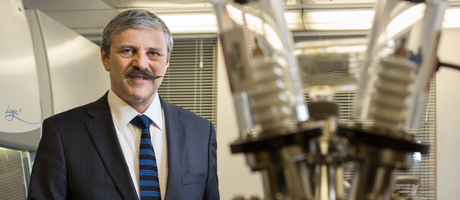A team led by Professor of Chemistry Akos Vertes will receive up to $14.6 million over five years from the Defense Advanced Research Projects Agency (DARPA) to find a way to rapidly identify the root of biological and chemical threats. The researchers are tasked with reducing to no more than 30 days a process that can often take years or even decades. If successful, their work could bolster national security efforts to thwart bio-chemical attacks.
“Clearly, this is a very large challenge, and it’s easy to understand why it’s important to overcome,” Vertes said. “Discovering the cause behind a biological or chemical threat can provide information that not only counteracts the threat but also provides important information for pharmaceutical companies developing drugs.”
GE Global Research, Protea Biosciences Inc., and SRI International will collaborate with Vertes on the project, titled “New Tools for Comparative Systems Biology of Threat Agent Action Mechanisms.”
Impact of Toxic Agents
Some potential biological weapons, like anthrax, are derived from bacteria. Others are synthesized from viruses, toxins, or fungi. Chemical threats include substances that interfere with the human nervous system or can cause asphyxiation. In the hands of terrorists, these hazards have the potential to cause widespread injury or death.
Vertes’s team will examine the effects of toxic agents on genes, proteins, and cellular functions using a spectrum of scientific disciplines—transcriptomics, proteomics, metabolomics, and bioinformatics—to meet the 30-day challenge. By combining an immense amount of data gleaned from these disciplines, researchers believe it will be easier to determine how specific biological or chemical threats work in a given environment.
One problem in heading-off potential threats is the fact that the field of metabolomics isn’t as well-developed as other scientific disciplines. To counter this obstacle, Vertes and his team developed the Laser Ablation Electrospray Ionization (LAESI) technique, which allows researchers to more quickly and effectively learn the chemical composition of a biological sample. The technique was licensed to Protea Biosciences Inc., developers of the commercial product, called the LAESI-DP 1000 Direct Ionization System.
To learn more about LAESI and the work of Vertes and his research group, visit his site.


